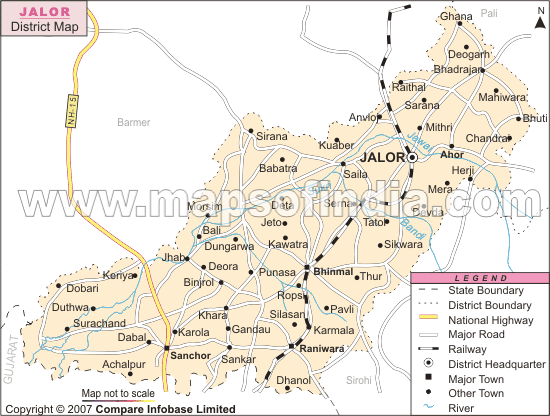Sanchore

Sanchore or Sanchor (सांचोर) town and tahsil in Jalor district in Rajasthan. Its ancient name was Satyapura (सत्यपुर).
History
Located on National Highway No 15, the town is situated 154 km from Jalore. Sanchore is a historical town and in olden days was known as Satyapur. It was ruled by Jalore Chauhan rulers. Alhan's son Vijay Singh from Nadol branch had established Satyapura (Sanchor) branch of Chauhans.
There is a well-known Jain temple in the town. A cattle fair is held here every year in April and May.
Villages in Sanchore tahsil
Achalpur, Agar, Agrawa, Akoli, Akoriya, Amarpura, Amarpura, Amba Ki Goliya, Amli, Ankhol, Arnay, Arwa, Bagli, Bagsari, Balana, Balera, Bali Khera, Bank, Bapunagar, Barsal Ki Beri, Barsam, Bawarla, Bhadoo Ki Dhani, Bhadroon, Bhadroona, Bharkua, Bharwal, Bhatki, Bhatwas, Bhawatra, Bheemgura, Bhootel, Bhuwana, Bichhawari, Bijrol Goliya, Bijrol Khera, Borli, Charneem, Chaura, Chhajara, Chimra, Chitalwana, Dabal, Dadhoora, Dadoosan, Dangra, Danta, Dantiya, Daukiyaon Ki Dhani, Dawal, Dedwa, Deora, Dhamana, Dhaneriya, Dhanta, Dharnawas, Dheengpura, Dhoorwa, Doogri, Doothwa, Dugawa, Galifa, Gangasar, Gardali, Godaron Ki Dhani (Hanumanji Ka Sthan), Golasan, Gomi, Goyton Ki Dhani, Gundav, Gura Hema, Hadecha, Hadetar, Hali Bao, Hanuwantpura, Haripura, Hariyali, Hidwara, Hoti Gaon, Isrol, Itada, Jaisla, Jajoosan, Jakhal, Jalberi, Janvi, Jelatra, Jerol, Jhab, Jhotra, Jodhawas, Joradar, K.R.Bandha Kua, Kachhela, Kailash Nagar, Kalji Ki Beri, Kamalpura, Kantol, Karawari, Karola, Keriya, Kesoori, Khamrai, Khaprol Ki Dhani, Khara, Khasarvi, Khejariyali, Khirodi, Kilawa, Kiloopiya, Kod, Kola Rebariyon Ki Dhani, Kukdeeya, Kundaki, Kura, Lachhiwar, Lachhiwar Ka Goliya, Lachhri, Lalpur, Liyadra, Looniyasar, Madhopura, Mailabas Charnan, Mailawas Gusaiyan, Maliyon Ka Goliya, Malwara, Mandali, Martawa, Marwari Kalbiyon Ka Goliya, Meda Jageer, Medha, Meerpura, Meghawa, Mooli, Nagolri, Nainol, Naldhara, Narayanpura, Nimbaj, Nimbau, Padaradi, Padardi, Paharpura, Paladar, Palri Deoran, Palri Solankiyan, Pamana, Panchla, Parawa, Pathmera, Pawta, Phalna, Phogarwa, Prajapati Nagar, Pratappura, Pur, Rado Ki Dhani, Raghunathpura, Raipuriya, Rajeshwar Pura, Rampura, Rampura, Ranodar, Ratanpura, Rataura, Ridka, Sahu Ki Dhani, Saili, Sanchore (M), Sangarwa, Sankar, Sankariya, Sarnau, Sarwana, Sayar Ka Koseeta, Sediya, Sensawa, Shivpura, Siddheshwar, Siloo, Siloosan, Siwara, Siyako Ki Dhani, Soonthri, Sunta Koi, Surachand, Surawa, Suthana, Tanpi, Tatra, Teetop, Tembi, Tetrol Rathoran, Tetrol Sunakhera, Umarkot, Vamal, Vandeo, Vapa, Varanpuri, Varanwa, Vasan Chauhan, Vasan Deoran, Veerawa, Veriya, Virol Bari, Virol Chhoti, Vishanpur, Vishnu Nagar, Vodha,
XXI Sanchor Stone Inscription of Samantasimha V.S. 1345 (1288 AD)
The stone on which the insoription was incised was found at Sanchor, the principal town of the district of the same name in the Jodhpur State. It was lying loose in the prison room attached to the kachehri. It contains 16 lines. Though weathered whole of ihc inscription can be read with certainty. The characters are Nagari. The language is Sanskrit, and the record is in prose. As regards orthography, the only points that call for notice are (1) the doubling of a consonant following an r, and (2) the use of the form simarata for samanta. As to lexicography, the following words may be noticed: (1) sthitaka in LL. 5, 7, 9 and 11, and (2) Selahatha or Selahasta together with their abbreviated forms in LL. 10, 12, 13 and 15. The first word seems to have been used in the sense of "a grant in perpetuity," and occurs in other inscriptions also, e.g. the Cintra prasasti of Sarangadeva, verses 53, 60, 61 and 66. The meaning of selahasta is not certain. And I know of only two records, viz. the Bhinmal inscriptions Nos. XII and XV s where the word occurs. In the first of these, line 12 has Srikaranya panchakula-selahatha-Ḍabhinarapalaṁ cha. Here it is worthy of note that selahatha occupies a position between panchakula, i.e. the modern pancha and Dabhinarapala, i.e. a king of the Dabhi race. And it seams tempting, therefore, to suppose that selahasta was an officer of high rank, higher at any rate than the village srikarana, which was held by one of ite panchaknla. Again, the expression selahath-abhavya occurs in both the Bhinmal inscriptions just referred to. It muat be taken to mean "the income collected by a selahatha". Probably he was connected with the revenue department. The inscription commences by specifying the date, wz. Monday, the 14th of the bright half of Karttika in the [Vikrama] year 1345. The Mahrajakula Samvatasimhadeva was the king, and at the holy place (mahasthana) of Satyapura (Sanchor), the pancha, consisting of the mahamta Hira and others appointed by him, was exercising local authority. The epigraph then records a grant in perpetuity of 8 Visala-priya drammas by the Meharas Prabha, Padama and Asapala. All the Meharas are requested to see to the continuance of this grant. According to this endowment, and the selahasta was requested to look after this matter. The selahasta is also desired to supervise personally the yatra festival of the god Vaesvara. Then follow, in token of approval, the sign-manuals of at least four Meharas, of whom three were the donors named above and the fourth was the selahasta Patala.
Reference - Epigraphia Indica Vol. XI (1911-12): A S I, Edited by E. Hultzsoh, Ph.D. pp.57-59
Notes by Wiki editor -
- Dabhi - Ḍabhinarapalaṁ word seems to be a title for Dabhi race mentioned here is probably related with Jat clan Dahba. Dahba is a Muslim Jat clan found in Pakistan.
- Selahatha (सेलहाथ)/ Selahastha (सेलहस्थ) - Selahatha or Selahasta together with their abbreviated forms is used in LL. 10, 12, 13 and 15. Sel (सेल) Sail (सैल) Shail (शैल) Selaniya (सेलाणिया) Selania (सेलाणिया) is gotra of Jats found in Rajasthan and Madhya Pradesh.
Notable persons
External links
References
Back to Rajasthan

